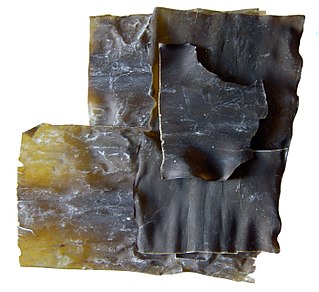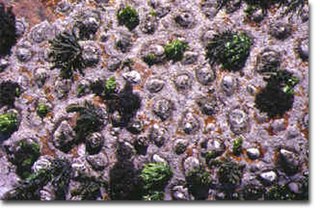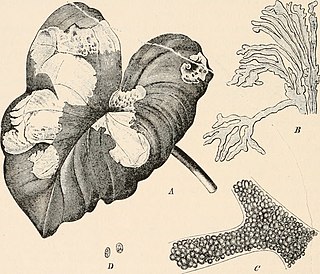
Konbu is edible kelp mostly from the family Laminariaceae and is widely eaten in East Asia. It may also be referred to as dasima or haidai.
Prymnesium parvum is a species of haptophyte. The species is of concern because of its ability to produce the phycotoxin prymnesin. It is a flagellated alga that is normally found suspended in the water column. It was first identified in North America in 1985, but it is not known if it was introduced artificially or missed in previous surveys. Toxin production mainly kills fish and appears to have little effect on cattle or humans. This distinguishes it from a red tide, which is an algal bloom whose toxins lead to harmful effects in people. Although no harmful effects are known, it is recommended not to consume dead or dying fish exposed to a P. parvum bloom.

AlgaeBase is a global species database of information on all groups of algae, both marine and freshwater, as well as sea-grass.
Ascoseira is a monotypic genus of seaweed in the brown algae. The single and type species, Ascoseira mirabilis Skottsberg, is a large parenchymatous macroalgae, and is endemic to the Antarctic Ocean. Ascoseira is assigned to its own order. The alga grows in subtidal waters at depths of from 3 to 15 meters.
Ourococcus is a genus of green algae, in the family Coccomyxaceae. As of February 2022, although AlgaeBase states that the genus is "accepted taxonomically", the type species Ourococcus bicaudatus is said to be a synonym of Keratococcus bicaudatus, and no species of the genus are listed as accepted.
Pleurastrum is a genus of green algae, specifically of the Chlorophyceae. As of February 2022, it was the only genus in the family Pleurastraceae.
Dimorphococcopsis is a genus of green algae, in the family Dictyosphaeriaceae. As of February 2022, the only species is Dimorphococcopsis fritschii.
Actinochloridaceae is a family of green algae, in the order Chlamydomonadales.
Palmogloea is a genus of green algae, in the family Coccomyxaceae. As of February 2022, the only "accepted" species listed by AlgaeBase was Palmogloea protuberans(Smith) Kützing, although many more species were listed as "preliminary".

Saccharina japonica is a marine species of the Phaeophyceae class, a type of kelp or seaweed, which is extensively cultivated on ropes between the seas of China, Japan and Korea. It has the common name sweet kelp. It is widely eaten in East Asia. A commercially important species, S. japonica is also called ma-konbu (真昆布) in Japanese, dasima (다시마) in Korean and hǎidài (海带) in Chinese. Large harvests are produced by rope cultivation which is a simple method of growing seaweeds by attaching them to floating ropes in the ocean.
Chlororustica is a genus of green algae, in the family Chlorococcaceae. Its sole species is Chlororustica terrestris, synonym Ettlia terrestris, a fresh-water alga which grows on rocks or in soil, and has been identified in the Arctic, Tajikistan, Europe and Jamaica.

Scutellastra cochlear is a species of sea snail, a marine gastropod mollusc in the family Patellidae, one of the families of true limpets. It is commonly known as the snail patella, the pear limpet or the spoon limpet and is native to South Africa. It often grows in association with the crustose coralline alga Spongites yendoi and a filamentous red alga which it cultivates in a garden. It was first described by the malacologist Ignaz von Born in 1778 as Patella cochlear.

Chaetophora elegans is the type species in the algae genus Chaetophora.

Trentepohlia aurea is a species of filamentous terrestrial green alga with a worldwide distribution. It grows on rocks, old walls and the trunks and branches of trees such as oaks, elms, and the Monterey cypress. The orange coloration results from carotenoid pigments in the algal cells. It is probably the most widespread and abundant species of Trentepohlia in the Britain and Ireland.
Lobophora variegata is a species of small thalloid brown alga which grows intertidally or in shallow water in tropical and warm temperate seas. It has three basic forms, being sometimes ruffled, sometimes reclining and sometimes encrusting, and each form is typically found in a different habitat. This seaweed occurs worldwide. It is the type species of the genus Lobophora, the type locality being the Antilles in the West Indies.

Spongites yendoi is a species of crustose red seaweed with a hard, calcareous skeleton in the family Corallinaceae. It is found on the lower shore as part of a diverse community in the southeastern Atlantic Ocean and the Indo-Pacific Ocean.

Phyllosiphon is a genus of parasitic green algae in the class Trebouxiophyceae.

Acetabularia acetabulum is a species of green alga in the family Polyphysaceae. It is found in the Mediterranean Sea at a depth of one to two metres.

Phyllophora antarctica is a species of red alga in the family Phyllophoraceae. It is native to Antarctica where it grows in dim light on the underside of sea ice. Some of it becomes detached and accumulates in drifts on the seabed. Many different organisms live attached to the fronds or among them.
Zanardinia is a monotypic genus of seaweed in the brown algae. The only species, Zanardinia typus, commonly known as penny weed, is native to the northeastern Atlantic Ocean and the Mediterranean Sea.









